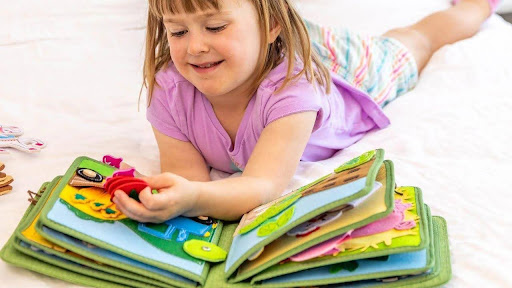One of the very crucial things in early learning is emotional development. Toddlers at this age start noticing, expressing and dealing with a vast number of emotions, both positive and negative ones, including happiness and excitement, frustration and depression. Being able to make them comprehend these feelings at an early age will be the source of empathy, communication, and emotional intelligence. Montessori education focuses on the process of learning based on practical experiences, the ability to express oneself and sensory exploration. Busy Books are the ideal materials to facilitate this process, by My First Book. They offer an imaginative and interactive experience of children learning their emotions as they play in a meaningful manner. Visit the website now https://myfirstbook.us/collections/montessori-inspired-fabric-busy-book.
Why Emotions Are Important in Early Learning
Emotional awareness is crucial to being able to develop empathy, social awareness, and self-control. Children who learn to tell what they are feeling have an opportunity to react to challenges in a healthier manner.
Toddlerhood is a time when a child can have huge emotions but cannot put them into words. A busy book based on Montessori helps in overcoming this gap. Every activity page enables the child to relate actions with emotion, such as closing a zipper, which may be associated with the idea of calming down, and matching smiling faces, which may be related to happiness and friendship.
My First Book: Effectiveness in Emotional Learning
Fabric busy books are different in the fact that they provide multi-sensory learning. Smooth textures, color images and interactive functions stimulate more than one sense simultaneously, which is the most effective in terms of emotional growth.
The following is the support that emotional exploration can receive through Montessori fabric busy books:
- Touch enables children to calm themselves down and to control their emotions.
- Colours can be used to convey moods. Light colours can be used to express happiness, whereas blue and dark colours can be used to describe relaxation.
- The play that is based on stories enables children to develop situations in which emotions are safely experienced and learnt.
- Each page is repeated and ordered, creating a feeling of control and stability, which creates emotional security.
- All the interactions, such as the buttons on a fabric doll or the zipper on a pouch, will teach problem-solving and patience, and the emotional balance will be strengthened by play.
Identifying the Emotions Using the Characters
It is important to tell parents that storytelling is one of the most efficient ways of emotional education. The friendly characters (animals, people or imaginary creatures) and their expressive faces and familiar situations are often represented in the Montessori busy books.
Children can learn what it is like to be the characters in different predicaments. As an example, a cow on the Busy Farm Book can be depicted as happy when it eats, and an animal can be shown as sad when it has lost a toy. These prompts are story-centered and help children build emotional vocabulary and empathy. They get the chance of making acquaintance with the expression of the feelings of joy, sorrow, apprehension or excitement, which are the basic building blocks with the help of which they get to know their own emotional self.

Calming and Centering Sensory Play
Sensory play is an effective method of getting the emotions of toddlers under control when they feel overwhelmed. Montessori busy books by My First Book contain very calming exercises like zipping, buttoning, lacing and touching textured materials.
The movements provide the children with a feeling of control and enable them to divert the energy of restlessness to attention. The emotional regulation is supported by the rhythmical movement of buttons or following soft textures. One such example is when a child is anxious; therefore, calming him down by quietly going through a page of similar shapes or zippers may be calming. Sensory input is a source of stress reduction, and it develops self-awareness, which is an important element of emotional intelligence.
Sharing Emotions by Being Creative
Imaginative and expressive play is also promoted by Montessori fabric busy books, and this enables children to roleplay emotions in a nonjudgmental, relatively safe environment. Parents and caretakers can participate by reading short stories with the child, with the help of the characters or pieces in the book. One child may make an animal character happy because he or she has solved a puzzle or can make a lonely character feel better. Such interactive situations foster empathy and make children learn how their behavior can affect others.
Learning Self-Regulation with Concentrated Activities
One of the fundamental skills that are naturally developed in Montessori busy books is self-regulation, or the capability to control emotions and behavior. Every mission in the book needs attention and concentration. Whether it is the process of tying shoelaces, unbuttoning buttons, or sorting colors, children are taught to be patient and then try again, and then they feel accomplished when they succeed. This routine of work and achievement trains a sense of emotional regulation and strength.
Enhancing Parent-Child Emotional Bond
An emotional attachment between the parent and the child is also further enhanced by exploring emotions through a Montessori busy book by My First Book. Joint play time will enable the parents to demonstrate how to express emotions, how to make the child feel accepted, and to provide a secure situation to talk without fear. Such caring processes explain to children that feelings are real and controllable. The relationship that is developed as a result of such play sessions gives rise to the feeling of trust, empathy and secure attachment: all of which are critical to emotional health.
Establishment of a Secure Zone
Montessori busy books give a stable and relaxing order to children to go back and relax any time they require it. The cushioning materials, the known activities, and the ease of learning provide them with a feeling of protection. This secure space makes the children open up their emotions. It also gives them an assurance that there is nothing wrong about feeling angry, confused, or excited and teaches them to express such feelings in the right way using play and communication. Children learn to trust themselves and grow emotionally in a safe environment, and this will boost their self-esteem even in life.
Conclusion
Busy Books made by My First Book are not mere play-things but entry points to emotional exploration. By exploring with fingers, telling stories, and playing creatively, these books enable children to interpret and control their emotions in a normal, natural and fun manner. Learning how to identify emotions, be patient and show empathy, children develop a high emotional intelligence, which, over the years, creates relationships, learning, and confidence in oneself. On every page, there is something more, something bigger than an activity. A child is also learning how to move about the world of emotions with curiosity, compassion, and calmness, whether he is zipping, matching, or reading stories.

















